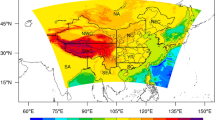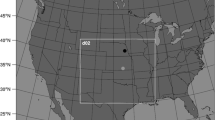Abstract
MODIS vegetation and albedo products provide a more realistic representation of surface conditions for input to the WRF/CMAQ modeling system. However, the initial evaluation of ingesting MODIS data into the system showed mixed results, with increased bias and error for 2-m temperature and reduced bias and error for 2-m mixing ratio. Recently, the WRF/CMAQ land surface and boundary layer processes have been updated. In this study, MODIS vegetation and albedo data are input to the updated WRF/CMAQ meteorology and air quality simulations for 2006 over a North American (NA) 12-km domain. The evaluation of the simulation results shows that the updated WRF/CMAQ system improves 2-m temperature estimates over the pre-update base modeling system estimates. The MODIS vegetation input produces a realistic spring green-up that progresses through time from the south to north. Overall, MODIS input reduces 2-m mixing ratio bias during the growing season. The NA west shows larger positive O3 bias during the growing season because of reduced gas phase deposition resulting from lower O3 deposition velocities driven by reduced vegetation cover. The O3 bias increase associated with the realistic vegetation representation indicates that further improvement may be needed in the WRF/CMAQ system.
Access this chapter
Tax calculation will be finalised at checkout
Purchases are for personal use only
Similar content being viewed by others
References
Gao F, Morisette J, Wolfe R, Ederer G, Pedelty J, Masuoka E, Myneni R, Tan B, Nightingale J (2008) An algorithm to produce temporally and spatially continuous MODIS-LAI time series. IEEE Geosci Remote Sens Lett 5(1):60–64
Hogrefe C, Pouliot G, Wong D, Torian A, Roselle S, Pleim J, Mathur R (2014) Annual application and evaluation of the online coupled WRF–CMAQ system over North America under AQMEII phase 2. Atmos Environ (in press)
Pleim JE, Ran L (2011) Surface flux modeling for air quality applications. Atmosphere 2(3):271–302
Pleim J, Gilliam AR, Appel W, Ran L (2015) Recent advances in modeling of the atmospheric boundary layer and land surface in the coupled WRF-CMAQ model. In: 34th International technical meeting on air pollution modelling and its application, Montpellier, France, 4–8 May 2015
Ran L, Gilliam R, Binkowski FS, Xiu A, Pleim J, Band L (2015) Sensitivity of the WRF/CMAQ modeling system to MODIS LAI, FPAR, and albedo. J Geophys Res Atmos (accepted)
Schaaf CB, Gao F, Strahler AH, Lucht W, Li X, Tsang T, Strugnell NC, Zhang X, Jin Y, Muller JP, Lewis P, Barnsley M, Hobson P, Disney M, Roberts G, Dunderdale M, Doll C, d’Entremont R, Hu B, Liang S, Privette JL (2002) First operational BRDF, albedo and nadir reflectance products from MODIS. Remote Sens Environ 83:135–148
Acknowledgments and Disclaimer
Although this work has been has been reviewed by EPA and approved for publication, it does not necessarily reflect their policies or views.
Author information
Authors and Affiliations
Corresponding author
Editor information
Editors and Affiliations
Question and Answer
Question and Answer
Questioner: D.G. Steyn.
Question: In many of your maps, you present variables (O3 & MLD) with strong diurnal variation at a fixed time (2000 UTC). Surely, it would be better to present these quantities at the same local time.
Answer: For the large scale modeling over the conterminous US domain which crosses four time zones, it is often questionable to select just one UTC time across the domain for displaying surface fluxes and deposition. Often, surface fluxes show big changes around peak temperature time which varies seasonally from around 2–3 pm LT in mid-winter to about 4–5 pm LT in mid-summer. Yes, it could be better to show the quantities at the same local summer time. We evaluated O3 and surface fluxes changes over different hours. It appears that O3 shows big difference around 20Z which corresponds to 1 and 2 pm for the Pacific and Mountain Daylight summer time zones. Thus, we selected 20Z to display the whole domain flux and O3 differences because most vegetation change from the use of MODIS input is in the US western drylands.
Rights and permissions
Copyright information
© 2016 Springer International Publishing Switzerland
About this paper
Cite this paper
Ran, L., Pleim, J., Gilliam, R., Hogrefe, C., Binkowski, F., Band, L. (2016). Application and Evaluation of MODIS LAI, FPAR, and Albedo Products in the WRF/CMAQ System. In: Steyn, D., Chaumerliac, N. (eds) Air Pollution Modeling and its Application XXIV. Springer Proceedings in Complexity. Springer, Cham. https://doi.org/10.1007/978-3-319-24478-5_100
Download citation
DOI: https://doi.org/10.1007/978-3-319-24478-5_100
Published:
Publisher Name: Springer, Cham
Print ISBN: 978-3-319-24476-1
Online ISBN: 978-3-319-24478-5
eBook Packages: Earth and Environmental ScienceEarth and Environmental Science (R0)




